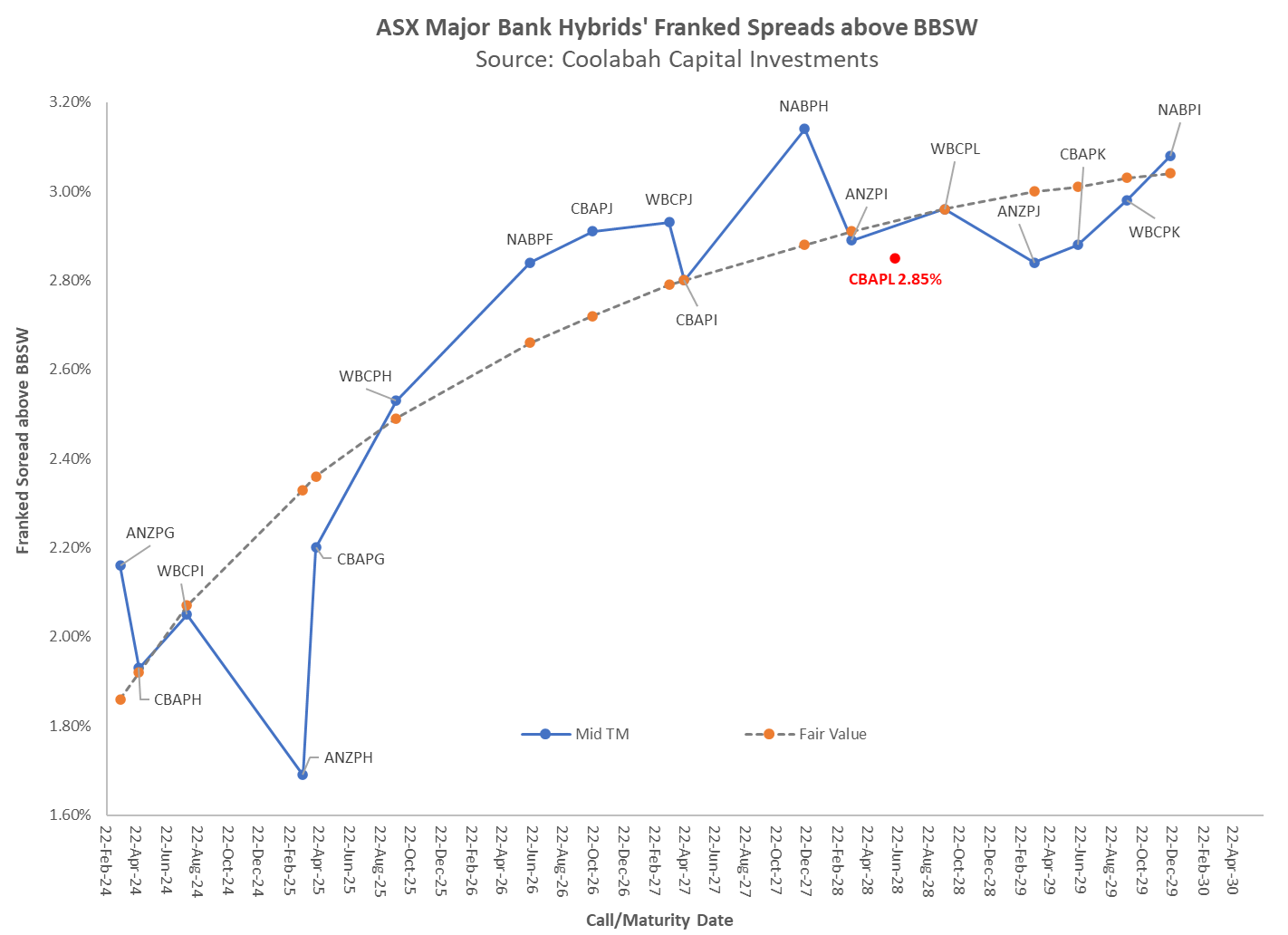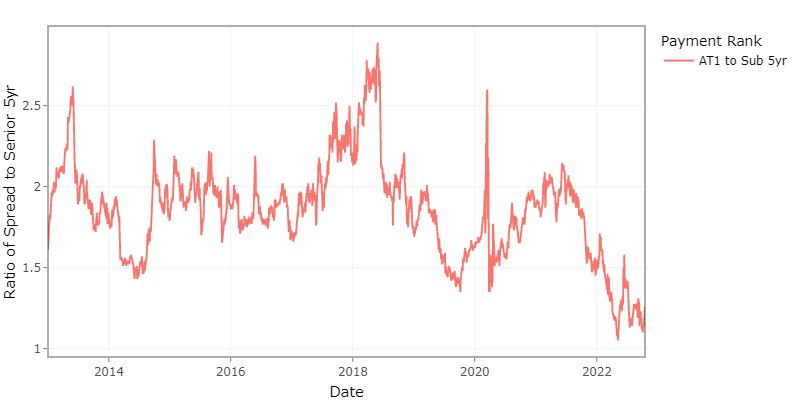New CBA hybrid looks expensive
CBA's latest hybrid deal (ASX: CBAPL) looks very expensive, even though it offers a superior 5.79% yield to the franked dividend yield on CBA's shares of 5.51%. Now understand this comes from an investor that is normally very supportive of CBA debt and hybrid deals: we ordinarily consider the bank to be one of the smartest issuers of debt globally. But for some reason, CBA appears to have exercised sub-optimal judgement on this new hybrid deal.
Let's consider the facts. First, the proposed credit spread, or extra income, above the quarterly bank bill swap rate is only 2.85% for an expected maturity (or "call date") of approximately 5.6 years. Based on the latest ASX pricing, our models suggest that fair value for a new CBA hybrid with a 5.6 year expected maturity is about 2.93% to 2.99% above BBSW. So unusually for CBA, they are proposing to pay a spread inside of, or worse than, ASX pricing. Put differently, you would be better off just picking-up cheaper hybrids on the listed market, all else being equal. As the chart below shows, hybrids from ANZ and Westpac that sit either side of the CBAPL security (specifically ANZPI and WBCPL) offer superior spreads.

Now BBSW is currently about 2.94%, which implies that CBAPL's total running yield will be the 2.85% spread added to BBSW: that is, a yield of approximately 5.79%. This yield is certainly much more attractive than it has been of late. Last year BBSW was sitting around 0.01%. It has recently risen to 2.94% largely as a function of the RBA lifting its cash rate by 2.5 percentage points to 2.60%. And 5-year major bank hybrid spreads were as low as 2.07% in December 2021: since that time, these spreads have gapped out to about 2.95% at the time of writing. So the all-in running yield for a 5-year major bank hybrid was just 2.08% in 2021 compared to the 5.79% yield on offer today, which might explain the deep retail demand for hybrids in recent months.
There are nonetheless a range of other factors that make CBAPL at 2.85% over BBSW unattractive to us. These include:
- The average 5-year major bank hybrid spread above BBSW since the introduction of the Basel 3 banking rules in 2013 has been around 3.45% above BBSW. So CBAPL is paying a spread that is some 0.60% lower than average. The chart below shows Coolabah's constant-maturity 5-year major bank hybrid spread index since the Basel 3 regulations came into being. You can see that current spreads appear tighter than normal despite the global risk-off environment.

- One step up a bank's capital structure we have Tier 2 bonds issued by the major banks. These bonds are safer than hybrids: they have higher credit ratings (BBB+ vs BBB-) and no automatic conversion into equity if a bank's common equity tier one ratio ever falls to 5.125%. They also rank above hybrids in the capital structure, and therefore get paid-out before them if a bank ever gets wound up. Whereas major bank hybrids are trading on credit spreads inside their average historic levels, the opposite is true of major bank Tier 2 bonds: they are currently trading at about 2.40% above BBSW, or 0.5 percentage points wide of their post-2013 average level of circa 1.90% above BBSW. In fact, we have been picking-up these Tier 2 bonds on spreads as high as 2.80% above BBSW.
- Our systems track the spread multiple 5-year major bank hybrids pay over 5-year major bank Tier 2 bonds, as you can see in the chart below. Normally, the major banks' hybrids pay you about 2x the spread you get on major bank Tier 2 bonds. Recently, this ratio has collapsed to just around 1.1x to 1.25x.

- On the same day that CBA launched its BBB- rated hybrid deal paying 2.85% above BBSW, the similarly rated Rabobank launched a Tier 2 issue rated BBB+ with a shorter 5-year maturity. And yet Rabobank is paying us a superior 2.95% spread above BBSW, or if we take the fixed-rate version of the bond, a fixed yield of 7.2% pa (there is no fixed-rate option for CBAPL).
- Like all good debt issuers, CBA normally pays a new issue concession with these deals of typically between 0.1% to 0.3% in extra annual income/spread. In the case of the new CBAPL security, CBA is actually paying a negative concession because the proposed spread is lower than the fair value spread on the ASX.
- Here it should be noted that the ASX hybrid market was massively bid-up in September and October despite global equities cratering and credit spreads generally moving wider. We have been suspicious of these moves, and have gradually rotated our own portfolios into safer major bank Tier 2 bonds, which pay similar all-in yields.
- You can get a sense of recent hybrid returns by examining performance of the active capital structure ETF product we run for BetaShares, which is called HBRD. Uniquely, HBRD has the flexibility of investing up and down the banks' capital structures, including in the majors' senior bonds (AA- rated), Tier 2 subordinated bonds (BBB+ rated), and of course their lower-ranking hybrid securities (BBB- rated).
- Over the 3 months to 30 September, HBRD returned 3.31% after fees including franking, which is an unusually strong quarterly result. Over the year to 30 September, HBRD returned 2.17% after fees (incl. franking). Over the same period, the AusBond Floating-Rate Note Index returned 0.48% while the fixed-rate AusBond Composite Bond Index lost 11.4%. If we look at riskier asset-classes like Aussie shares, the All Ordinaries Accumulation Index lost 8.6% over the year to September. The chart below shows 12 month returns on the left-hand-side in the blue bars juxtaposed against the current yields in the orange bars on the right-hand-side.

There is still a potentially very powerful case for maintaining an exposure to bank hybrids, which pay superior yields to the banks' senior bonds and Tier 2 bonds, but also, rather remarkably, to their underlying equities.
Grossed-up for franking credits, CBA's shares only pay a dividend yield of 5.51%, which is below the 5.79% running yield on the new CBA hybrid, CBAPL, even though the hybrid has much lower volatility and maximum losses than the underlying CBA shares, based on the experience since 2013... As one illustration, whereas HBRD lost about 4.5% in March 2020, bank stocks fell by 25%-35%.
Access Coolabah's intellectual edge
With the biggest team in investment-grade Australian fixed-income and over $7 billion in FUM, Coolabah Capital Investments publishes unique insights and research on markets and macroeconomics from around the world overlaid leveraging its 14 analysts and 5 portfolio managers.
4 topics

